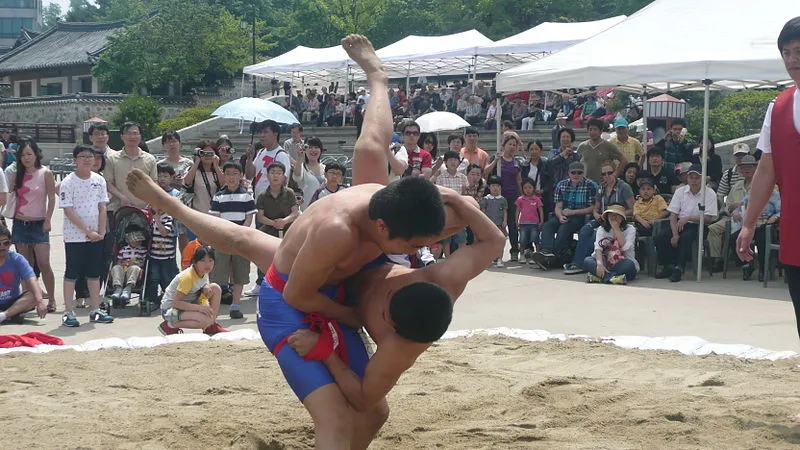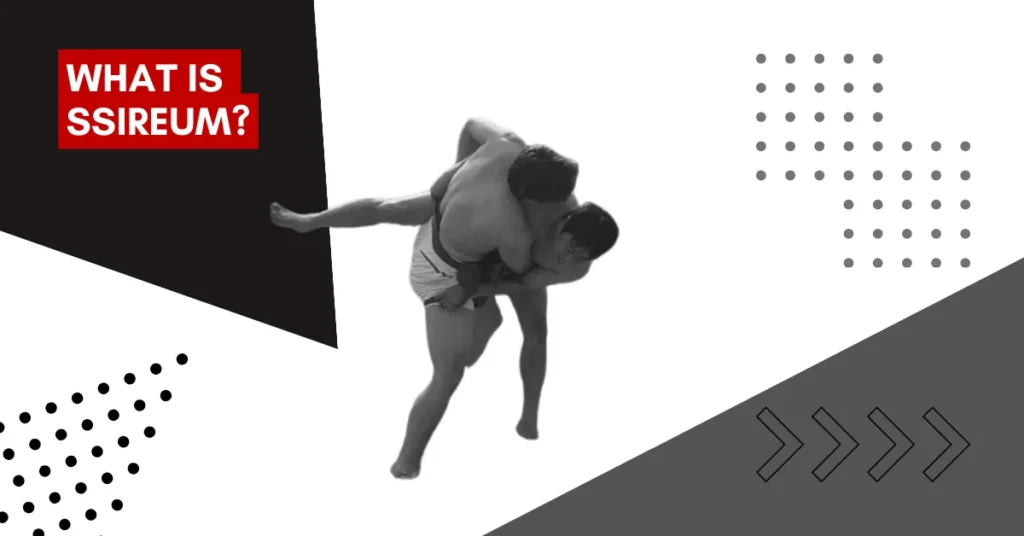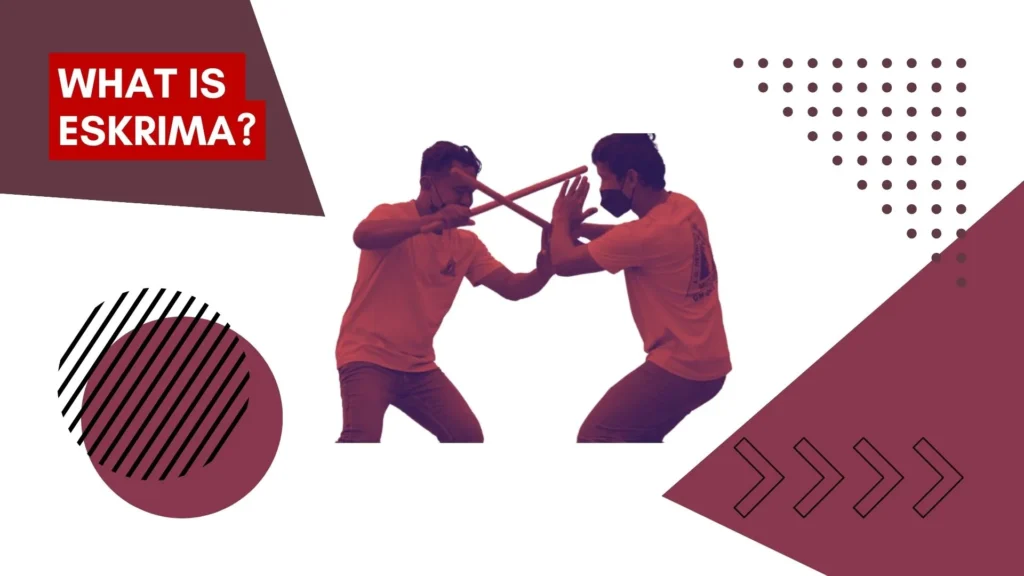Ssireum, or Korean wrestling, is the national sport of Korea and a traditional folk wrestling form. Its origins date back to the fourth century, and it holds great cultural and historical importance. Competitors in ssireum wear a belt known as a “satba” that encircles the waist and thighs. Any portion of the opponent’s body above the knee must be brought to the ground in order to win. In Korean culture, ssireum has long been a well-liked pastime. In the 20th century, it was elevated to the status of a nationally broadcast sport. UNESCO listed it as an intangible cultural treasure.
Table of Contents
Key Takeaways
- Ssireum is a traditional Korean wrestling style and the national sport of Korea.
- Competitors wear a belt called a “satba” and aim to bring their opponent’s body above the knee to the ground.
- Ssireum has a long history and is considered an intangible cultural heritage by UNESCO.
- It has gained popularity as a televised sport in Korea.
- Ssireum showcases the traditional wrestling techniques and cultural significance of Korea.
Mechanics and Techniques of Ssireum
In ssireum, wrestlers use a variety of techniques to try to throw their opponent to the ground. They employ a distinct wrestling style that has been passed down through generations, making it a traditional form of wrestling in Korea.
The objective of the match is to bring any part of the opponent’s body above the knee to the ground, requiring wrestlers to strategically target their opponent’s balance and position.

During a ssireum match, wrestlers focus on turning their opponent’s torso from about 45 degrees to 90 degrees, utilizing their strength, weight, and body positioning. They aim to shift their opponent’s weight backwards, ultimately grounding them.
One of the key elements of ssireum is the use of the opponent’s belt, called a “satba,” to gain leverage and control. Wrestlers lock onto each other’s belts, allowing them to manipulate their opponent’s movements and exploit their weaknesses.
Ssireum comprises various techniques that wrestlers employ to execute throws and takedowns without causing significant harm or injury. These techniques prioritize skill and finesse, emphasizing the strategic aspect of the sport.
The competition involves a combination of grappling, physical strength, and precise execution to gain the upper hand. Wrestlers utilize their knowledge and proficiency in different techniques to outmaneuver their opponents and secure victory.
Popular Ssireum Techniques
- Ack Jji: This technique involves lifting the opponent’s leg or legs to disrupt their balance and stability, making it easier to execute a throw or takedown.
- Ggum Jji: In this technique, the wrestler aims to lift and flip the opponent over, often using leverage to unbalance them and bring them to the ground.
- Doo Ryuh: Doo Ryuh is a technique where the wrestler attempts to grab the opponent’s belt or clothing and quickly spin them around, destabilizing their position and creating an opportunity for a throw.
- Jang Ko Gi: This technique involves lifting the opponent’s leg and sweeping it to the side, causing them to lose balance and fall.
- Sal Ko Gi: Sal Ko Gi focuses on grabbing the opponent’s ankle or leg and using leverage to topple them, leading to a successful takedown or throw.
These are just a few examples of the numerous techniques utilized in ssireum matches. Each wrestler brings their unique style and approach, resulting in an exciting and dynamic display of skill and athleticism.
By embracing the traditional principles of ssireum, wrestlers aim to outperform their opponents through a masterful combination of strength, technique, and strategy on the wrestling mat.
History and Cultural Significance of Ssireum
Ssireum has a long and storied history in Korean culture. Dating back to the Goguryeo period (37 BC – 668 AD), it has evolved from its roots as a military tactic into a beloved cultural sport that is celebrated to this day.
During the Goryeo and Joseon periods, ssireum emerged as a popular pastime for the Korean people. It became deeply intertwined with traditional holidays and festivals, where ssireum matches were eagerly anticipated events. These tournaments served as a platform to showcase the strength and skill of the wrestlers, attracting spectators from all walks of life.
One distinct aspect of traditional ssireum tournaments was the prized reward for the victor – an ox. As a symbol of strength and prosperity, the ox represented the traditional prize for the winner of these competitions. This tradition further solidified the cultural significance of ssireum in Korean society.
Over the centuries, ssireum has retained its cultural heritage status and continues to be celebrated as an integral part of Korean culture. Its historical significance in both martial and cultural contexts earned it recognition as an intangible cultural heritage by UNESCO, further cementing its value and importance. Today, ssireum holds a special place in the hearts of the Korean people and is cherished as a demonstration of their rich cultural legacy.
Historical Timeline of Ssireum
| Period | Significance |
|---|---|
| Goguryeo period (37 BC – 668 AD) | Earliest evidence of ssireum |
| Goryeo and Joseon periods (918–1897) | Ssireum becomes a popular pastime in Korean culture |
| 20th century | Ssireum gains national televised coverage and recognition as a national sport |
| Present day | Ssireum is recognized as an intangible cultural heritage by UNESCO |
Ssireum Competitions and Events
South Korea and North Korea host various competitions and events dedicated to ssireum, showcasing the immense popularity and cultural significance of this traditional Korean wrestling style. These competitions provide an exciting platform for both local and international wrestlers to demonstrate their skills and engage in competitive matchups.
Korean Ssireum Championships
One of the most prestigious ssireum tournaments is the Korean Ssireum Championships, organized annually by the Korean Ssireum Association. This national competition brings together the best wrestlers from across the country, attracting a large audience and generating significant excitement.
- President’s Cup National Ssireum Competition: In addition to the Korean Ssireum Championships, the Korean Ssireum Association also organizes the President’s Cup National Ssireum Competition. This event features elite wrestlers competing for the coveted President’s Cup.
- Professional Sports Competition: Ssireum is not only a traditional sport but also a professional endeavor. Professional wrestlers participate in the Professional Sports Competition, showcasing their expertise and aiming to achieve victory.
- Folk Ssireum Competition: To honor the roots and cultural heritage of ssireum, the Folk Ssireum Competition is held, allowing wrestlers to showcase traditional techniques and entertain spectators with a glimpse into the sport’s historical significance.
- Amateur Sports Competition: The Amateur Sports Competition provides an opportunity for aspiring wrestlers and enthusiasts of all skill levels to engage in friendly ssireum matches, fostering a sense of community and passion for the sport.
World Ssireum Championships
On an international level, the World Ssireum Championships stands as a pinnacle of ssireum excellence. Wrestlers from around the world come together to compete and showcase their skills on a global stage. This prestigious tournament not only highlights the talent and athleticism of the participants but also promotes cultural exchange and appreciation.
The World Ssireum Championships serves as a melting pot of diverse wrestling styles and techniques, further elevating the global appeal and recognition of ssireum. It provides a unique platform for international wrestlers to demonstrate their prowess and compete against elite athletes from different backgrounds.
Conclusion
Ssireum, the traditional Korean wrestling style, holds great cultural significance in Korean society. Originally developed as a survival tactic, it has transformed into a beloved form of entertainment during festivals and holiday celebrations. Ssireum competitions not only showcase the physical strength and skill of the wrestlers but also embody the harmony and spirit of Korean culture.
With its inclusion as an intangible cultural heritage by UNESCO, ssireum has gained global recognition as a treasured part of Korean tradition. Its enduring popularity and thrilling matches continue to captivate audiences both within and outside of Korea.
The benefits of ssireum go beyond its entertainment value. This traditional Korean wrestling style promotes physical fitness, discipline, and strategic thinking. It encourages the development of teamwork and perseverance, making it a holistic sport that nurtures both the body and the mind.
As ssireum preserves its rich heritage and cultural significance, it continues to inspire people around the world. From its ancient origins to its modern-day competitions, this traditional sport serves as a testament to the resilience and vitality of Korean culture.
FAQ
What is ssireum?
Ssireum, also known as Korean wrestling, is a traditional folk wrestling style and the national sport of Korea.
Is ssireum related to sumo?
Ssireum is related to sumo in that both sports share aesthetic similarities. However, they differ in the rules of victory. Sumo wrestlers win by shoving opponents outside the field of play, while in ssireum, players lose when any part of their body above the knee touches the ground.
Does Korea have sumo?
Korea does not have sumo as its traditional sport. Instead, it has ssireum, which is a distinct form of wrestling.
How do you pronounce ssireum in English?
Ssireum is pronounced as SHEE-rum in English.
What techniques are used in ssireum?
Ssireum involves a variety of techniques to try to throw the opponent to the ground. Wrestlers use their body positioning and weight shifting to gain an advantage and bring their opponent’s body above the knee to the ground.
Is ssireum only popular in Korea?
While ssireum is rooted in Korean culture and holds a significant place in Korean society, it has gained recognition on a global scale as well. International wrestlers compete in ssireum competitions, and some ssireum practitioners have gone on to succeed in other combat sports.



